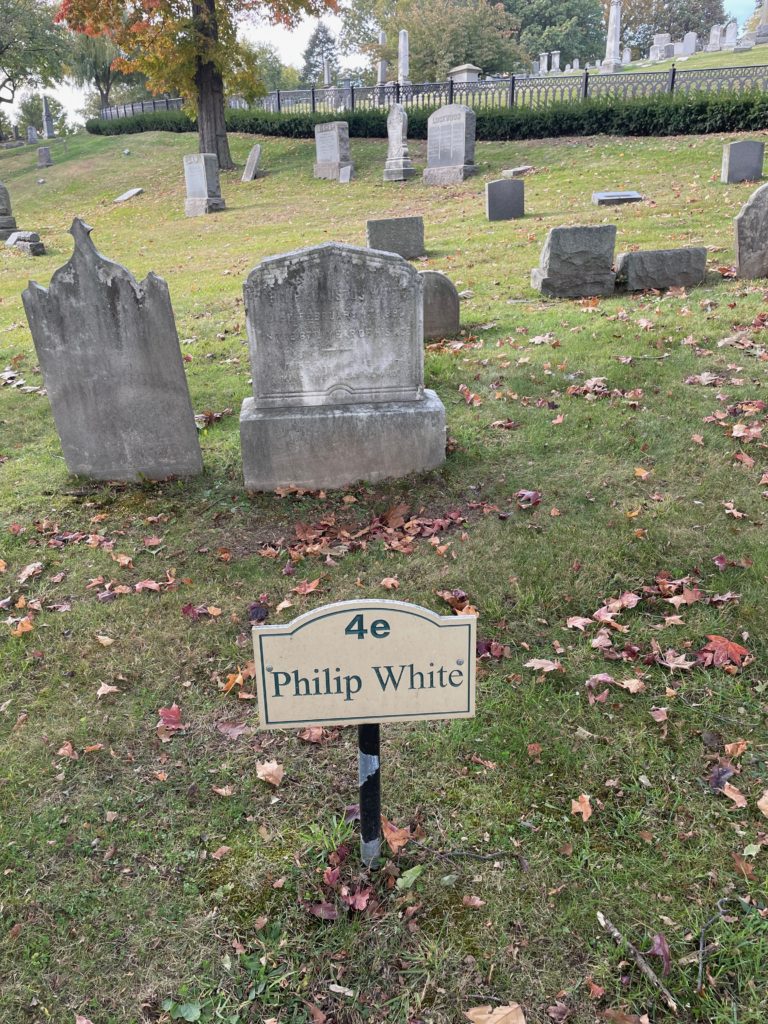Erik Visits an American Grave, Part 1,135
This is the grave of Philip White.

Born in 1823 in Hoboken, New Jersey, White is an excellent example of the oddities of how Americans consider race. His father was an English immigrant and grocer. His mother was a light skinned mulatto woman from Jamaica. At the most, White was 1/8 African. It’s not that he could pass as white so much as it was hard to believe he wasn’t 100% white. But because this was the United States with its bizarre one-drop obsession, a quite different conceptualization of race than the rest of the Americas, White was a Black man in a racist time. In 1831, the family moved to Manhattan.
The family did have some money. White would identify as Black always. But that didn’t necessarily mean there was massive solidarity among the Black community. Colorism is a well known phenomenon in Black American history and there was an absolute aristocracy within the Black community based on both color and money. That White would embrace. In 1840, White became an apprentice in the pharmacy owned by James McCune Smith, the pioneering Black doctor and abolitionist. He then was accepted into the College of Pharmacy of the City of New York. He graduated from that and joined Smith in operating the most important Black-owned pharmacies in the city. Because of the lack of medical care for Black New Yorkers and the inability of most of them to pay for what might be available, these pharmacies also became impromptu clinics for treating minor aliments that people had.
White married another wealthy light-skinned Black person in Elizabeth Guignon. They had several daughters, all of which also married wealthy light-skinned Black men. This is how the Black aristocracy repeated itself through the generations. This didn’t mean that he wasn’t concerned with the situation that the major of Black New Yorkers faced. He definitely was. But those class and color divides were strong. He was a member of St. Philip’s Episcopal Church, the wealthiest Black church in the United States. But again, this doesn’t mean that he avoided the reality of Black life for most people. He took a different position on it. That meant engaging heavily in charitable campaigns, for instance. One example of this is him hosting debutante balls for other members of the Black aristocracy as fundraisers for the New York African Society for Mutual Relief, a charity organization. And in fact, he suffered in his attempts to rise in society as was so common during these years. For example, he and two other members of his church were the first Black delegates to the New York Episcopal Diocesan Convention. They had certainly earned it. But the white delegates were outraged. They had to sit next to and be around Black Episcopalians? It was one thing for them to have their own church, but to be respected and admitted into white society? This is kind of thing even a light-skinned reasonably wealthy man like White had to deal with all the time.
But White did more than this too. He volunteered to teach classes for Black adults to allow them to improve their minds and abilities to make a living and learn about politics, for instance. Supposedly, he was a good and inspiring teacher. In 1851, he became the secretary for the Society of Education Among Colored Children, holding this position until sometime around the end of the Civil War. In fact, his interest in education was so great that he managed to be on the actual Brooklyn Board of Education for a time in the 1880s, a remarkable thing for a Black man during these pretty terrible years for civil rights. He worked to build schools for Black students around New York and also did a lot of work on creating orphan asylums. His pharmacy was also critical for the extension of credit within the Black community, which allowed any number of people to move forward and make ends meet for a day or two at least. It’s a lot more than nothing.
White died in 1891, at the age of 67.
Philip White is buried in Cypress Hills Cemetery, Brooklyn, New York.
If you would like this series to visit other 19th century Black community leaders, you can donate to cover the required expenses here. Robert Smalls is in Beaufort, South Carolina and Richard Allen is in Philadelphia. Previous posts in this series are archived here.
